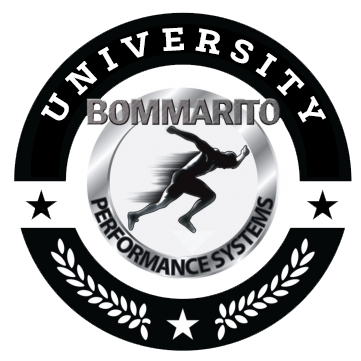This variation of lateral med ball slams is all about stability. There are many different factors here that are at play within this rather simple looking exercise. Stability is all about the isometrics. This dynamic lateral mb slam isometrically loads the trunk/spine extensors and lateral flexors. Also, pay attention to the alignment of the feet. The use of a low split-stance causes the adductors to stay active, therefore stabilizing the SI Joint. We are also set up in an “unsupported” stance. This means that the knee is off the ground. By doing this unsupported, we are able to overload the challenge at the toe, foot, ankle, and knee joints. All in all, the whole body is being isometrically stabilized throughout this movement. Try it out and let us know what you think!
DETAILED COACHING VIDEOS
Speed-Strength Box Squat
Box Squat; X1X Tempo; Transformer Bar (Back Squat Low Position); Double Strong Bands; 3 Chains; 1.0m/s
10×2 (Complex with depth Jumps)
THIS IS a way to PEAK POWER on a Conjugate Phase. Note Power is all about the dynamic eccentric hold AND concentric power where you can accelerate through the end ROM. This setup allows for both – at very high levels.
WAY MORE effective than Olympic Lifts
CB Speed High Box Squat (31X) – Bands
Ascending/Descending Phase
1.
MAX EFFORT. Supine Hip Bridge – HEAVY (note he gets to 6 Strong bands)
2.
SPEED STRENGTH. Kirocore Flexline Explosive Stepups
3.
LOADED POWER. Proteus Rotations
4.
UNLOADED POWER. Band Assisted Depth Jumps
After 4 rounds of this 4-set complex, we hit Posterior Chain complex:
1.
Glute Ham Raise
2.
PB SL Russian Hamstring
During this peak power phase, it’s always good to map it with Max Effort Sprinting. Note the timed sprints – 2pt start and Base-Stealing Starts. The 10-20yd split tracking being the most ideal.
Also note the BIOMETRICS are the key in the weight room. Hence the data we get from a power and symmetry standpoint on the Proteus and Flexline is crucial. These biometrics are important to track the Post-Activation Potentiation affect, the Power symmetry, and PEAKING power based on previous phases.
Basic Jump Cut Series
Linear
Basic Crunch – Side Bend Iso (band resist)
Basic Crunch With Band Diverging Lateral Force
With Trunk/Spine development, the number one rule of thumb is to NOT combine concentric motions. However, it’s extremely important to combine muscle groups in the same exercise – just have one motion concentric, and the other motion(s) isomeric.
This is a good example – the Basic Crunch (232 Tempo), Band Diverging Lateral Force.
Note that trunk flexion is working concentric / eccentric. However, the isometric force is placed on the trunk rotators at the bottom of the crunch, and on the trunk lateral flexors at the top of the crunch. This simple band attachment allows for the “combining muscle groups” in the same exercise. WITHOUT having unnecessary stress on the spine (which occurs with many exercises that combine concentric motions – like exercises that seem harmless like a bicycle crunch or a MB/Plate side to side rotation).

